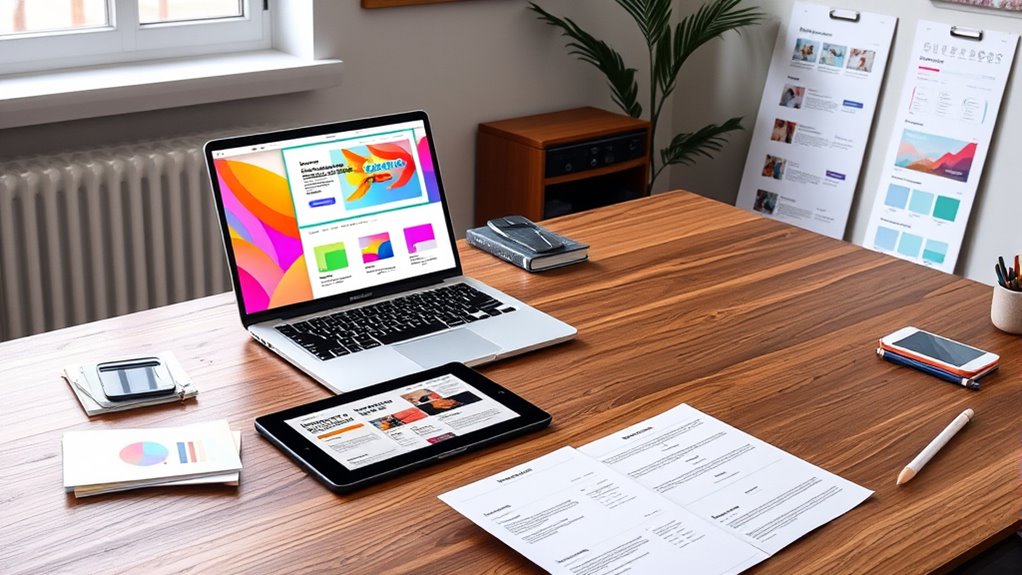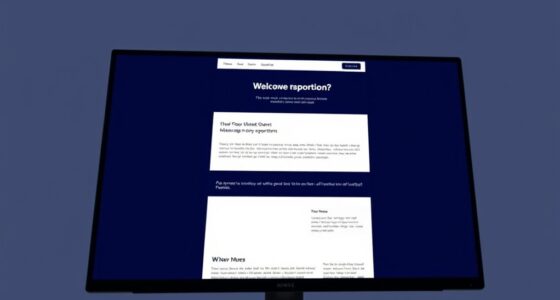To build reusable email templates for quick campaigns, focus on creating a flexible structure with a consistent layout, branding, and visual hierarchy. Use placeholders to personalize content easily and design modular blocks that can be swapped or customized to fit different goals. Keep core elements like headers, footers, and call-to-actions standardized to save time. By combining these strategies, you’ll streamline your outreach efforts and craft professional messages rapidly—explore further to master these approach details.
Key Takeaways
- Establish a flexible template structure with consistent header, footer, and branding elements for quick customization.
- Incorporate placeholders for personalized content like recipient names and specific details to streamline targeting.
- Use modular content blocks that can be easily swapped or adjusted depending on campaign goals.
- Maintain uniform design elements—colors, fonts, and layout—to ensure brand consistency and quick assembly.
- Include clear calls-to-action and visual hierarchy to enhance engagement and facilitate rapid deployment.

Reusable email templates streamline your communication process by allowing you to quickly send consistent, professional messages without starting from scratch each time. They’re especially valuable when you need to send multiple emails that share similar structure but require some degree of personalization. To make the most of these templates, you should focus on implementing effective personalization tactics. This means including placeholders for recipient names, company details, or specific references that you can easily customize before hitting send. Personalization not only makes your emails feel more genuine but also boosts engagement rates. When designing your templates, think about the flow of your message and how each element can be tailored to individual recipients without disrupting the overall structure. This approach guarantees that each email feels personalized, even though you’re using a standard template.
Reusable email templates enable quick, personalized, and professional communication without starting from scratch each time.
Design consistency plays a vital role in building reusable templates that look professional and trustworthy. By maintaining a uniform layout, color scheme, and font style across your templates, you reinforce your brand identity and create a seamless experience for your recipients. Consistent design also makes your emails easier to read and navigate, increasing the chances that your message will be understood and acted upon. When setting up your templates, pay attention to visual hierarchy—use headings, bullet points, and clear call-to-action buttons to guide the reader smoothly through your content. Additionally, understanding emotional support strategies can help you craft messages that resonate more deeply with your audience, fostering trust and engagement.
Having a solid structure in place allows you to swap out content blocks easily, saving time while ensuring that your message remains cohesive. Your templates should be flexible enough to accommodate different campaign goals, whether it’s a promotional offer, a follow-up, or an informational update. Keep core elements like your header, footer, and branding consistent, while allowing space for variable content that can be customized for each recipient. This balance between standardization and personalization will help you scale your outreach efforts efficiently without sacrificing quality.
Incorporating personalization tactics into well-designed, consistent templates ultimately equips you to send quick, effective campaigns that resonate with your audience. You’ll find that these templates not only streamline your workflow but also enhance your brand’s professionalism and reliability. As you develop your reusable email structures, remember that a well-crafted template is a foundation—one that saves you time, improves your message’s impact, and makes your communication more consistent across all your campaigns.
Frequently Asked Questions
How Do I Ensure My Templates Are Mobile-Friendly?
To guarantee your templates are mobile-friendly, focus on implementing responsive design that adapts to various screen sizes, making your content easy to read on any device. Use touch optimization by designing larger buttons and clickable areas, so users can navigate effortlessly. Test your templates across multiple devices and email clients, making adjustments as needed. This way, your emails will look great and function smoothly for all recipients.
What Tools Are Best for Creating Reusable Email Templates?
Imagine saving hours with tools that make template customization effortless while ensuring branding consistency. You should explore platforms like Mailchimp, HubSpot, or Stripo—they offer intuitive drag-and-drop editors, pre-designed blocks, and easy customization options. These tools help you create reusable email templates quickly, maintain your brand’s look, and adapt templates for different campaigns, giving you more time to focus on engaging your audience rather than designing from scratch.
How Can I Personalize Templates for Different Audiences?
You can personalize templates for different audiences by using dynamic content and audience segmentation. Incorporate dynamic content blocks that change based on recipient data, making each email more relevant. Segment your audience into groups with similar interests or behaviors, then tailor your messaging for each segment. This approach guarantees your emails resonate personally, boosting engagement and conversions while keeping your templates reusable across various campaigns.
What Are Common Mistakes to Avoid in Template Design?
Did you know that 40% of users delete emails that look unprofessional? To avoid this, you should prioritize design consistency and branding alignment. Common mistakes include inconsistent fonts, colors, and layouts, which can confuse recipients. Keep your templates visually cohesive, follow your brand guidelines, and use a clear hierarchy. This guarantees your emails look polished and trustworthy, encouraging higher engagement and brand recognition.
How Do I Track Performance of Email Campaigns Using Templates?
To track your email campaign performance using templates, focus on analytics metrics like open rates, click-through rates, and conversions. Use these insights to identify what works best. Incorporate A/B testing by experimenting with subject lines, content, and calls-to-action within your templates to optimize results. Regularly review these metrics and tests to refine your approach, ensuring your campaigns become more effective over time.
Conclusion
With reusable email templates, you paint a vibrant canvas for your campaigns, each stroke quick and effortless. Imagine your message flowing seamlessly like a well-oiled machine, ready to capture attention at a moment’s notice. As you refine your structures, your emails become familiar friends, always ready to greet your audience with consistency and clarity. Embrace these templates, and watch your campaigns bloom effortlessly, turning your ideas into a steady stream of impactful communication.









